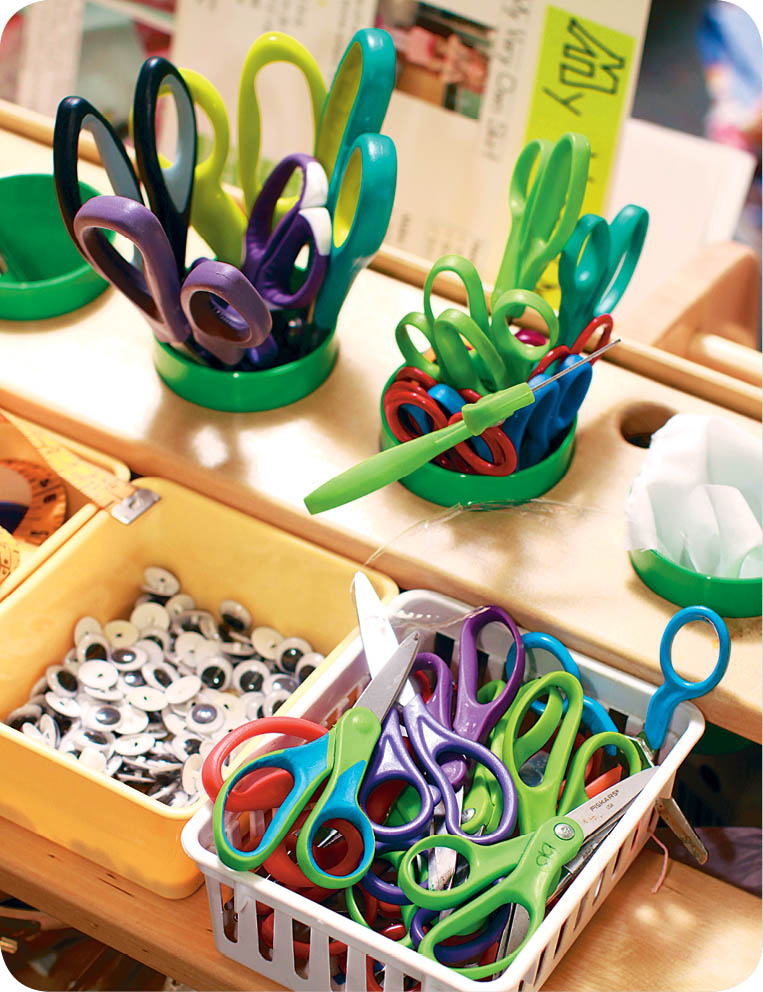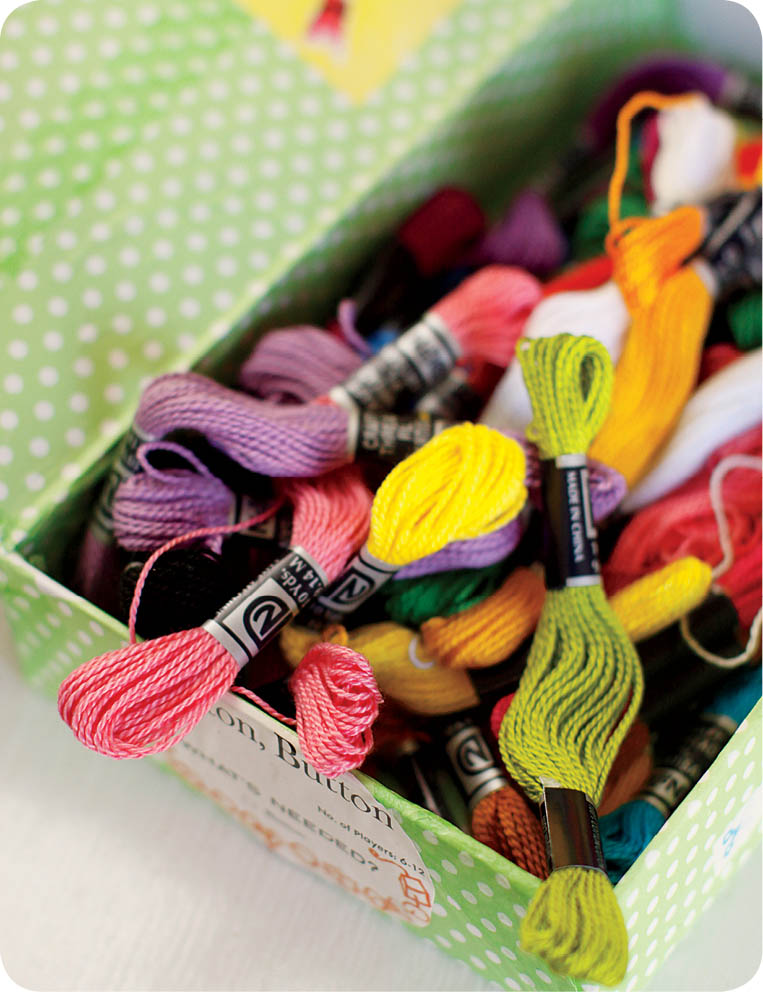
BOBBIN — A bobbin is something sturdy you wrap thread around to keep the thread from becoming a big, tangled mess. Look for plastic embroidery bobbins at a craft or fabric store, or you can easily make your own out of cardboard from the recycling bin (see How to Make a Bobbin).
BODKIN — This tool looks like a special set of tweezers. It will help you pull elastic or string through a casing. If you don’t have a bodkin, you can attach a large safety pin to the end of the elastic or string instead.

BUTTON — A button is an easy-to-sew fastener that comes in two styles. Flat buttons have two, four, or five holes for you to stitch through. Shank buttons have a metal or plastic loop on the back. In olden days, buttons were often made of wood, antlers, or bone. Now, most buttons are plastic. (See Lesson Eight to learn how to sew on buttons.)
CASING — A casing is a long, narrow pocket (or tunnel) of fabric that holds string or elastic. Sewing projects such as a drawstring pouch or a skirt with a stretchy waistband have casings. (See Lesson Eleven to learn how to make one.)
COTTON — Cotton fabric is made from the cotton plant. It is easy to cut and sew, but it is also quick to fray. Cotton fabric has a “good” side (see Fabric below), so be sure to pay attention when you’re cutting and sewing this kind of fabric.
ELASTIC — You will need this stretchy trim for a few projects in this book, such as the Sweet Dreams Mask and My Very Own Skirt. A good size elastic to buy is 1⁄2 inch wide.
EMBROIDERY — This style of sewing allows you to draw a picture with your needle and thread. For example, you might use a running stitch and some red thread to embroider a smile on a Your Little Friend pal.

FABRIC — Fabric is a material, or textile, that is created from millions of woven threads that are natural or man-made. The “good,” or “right,” side of the fabric, which is the one you want to show on the outside of your sewing projects, is usually brighter than the other side.
FABRIC GLUE — This is a special kind of glue made to use on fabric. It often works well when you want to decorate a finished project with notions such as googly eyes or pieces of felt. We like Sobo Craft and Fabric Glue.
FELT — This is a thick, colorful fabric that won’t fray — and a good material for gluing or embroidering. Felt does not have a “good” side. Felt is often made from sheep’s wool, so sometimes it feels scratchy against your skin. You can layer felt with other fabrics when making projects like the Cute Coasters and the Too-Hot Holder.
FLEECE — If you want a fabric that is extrasoft, snuggly, and warm, fleece is a good choice. Fleece is a man-made fabric. Because it won’t fray, it is also a good fabric to use when you’re in a hurry to finish your project. It is perfect for some of the Hug and Wear projects, such as the Take-It-with-You Blanket, Hat Attack!, and the Sweet Dreams Mask.
MUSLIN — Muslin is a thin cotton fabric that is good for drawing and tracing. You will want to use muslin when you make a Stuffie. You can also create your own fabric design by decorating a piece of muslin with crayons or fabric markers.
NEEDLE — A needle is your most important tool for sewing. It has an eye, or hole, on one end and a point on the other (see Anatomy of a Needle). We like to use a chenille size 22 sharp point needle. Its large eye makes it easy for young sewers to thread.
NEEDLE THREADER — Threading a needle can be tricky. A needle threader is a small tool with a thin hook that will help you get the thread through the eye of the needle. Be sure to keep your needle threader with your spare needles. We like the LoRan Needle Threader for large-eye needles. Wire loop needle threaders can break easily when used with craft thread and large-eye needles.
NOTIONS — This includes ribbon, rickrack, lace, beads, sparkles, fabric scraps and trims, and other items you can use to make a face on a stuffed animal or doll. You can also use notions to decorate clothes and gifts.

PATTERN — This is a paper outline of shapes that you need to trace onto fabric and then cut out, before you can start sewing. For some projects, such as the So Soft Pillow, you can make your own patterns by drawing simple shapes onto construction paper or the flat part of a brown paper grocery bag. You can trace your pattern with a marker or a pencil, but we like using chalk best because it disappears when you brush it away.
RUNNING STITCH — The most basic sewing stitch is a running stitch. You can use a running stitch to attach two pieces of fabric together or to embroider a picture or a design. When it’s done right, the running stitch looks just like a dotted line. (See How to Sew a Running Stitch.)
SEAM ALLOWANCE — The space between your stitches and the edge of your fabric is called the seam allowance. Most of the seam allowances in this book are 1⁄4 inch wide. Think of it as a margin for your fabric. Don’t sew too close to the edge, or the fabric may fray and your stitches might fall out! If you are using a sewing machine, the seam allowance is the width of the machine’s presser foot.
SEWING KIT — For a sewing kit, you can use a box, a basket, or a bag that is the right size to hold all of your sewing supplies (see In Your Sewing Kit). A good sewing kit will have sewing scissors, a needle book, needles and thread, a needle threader, and a bodkin or safety pin for threading string or elastic through casings. It will also have a few other tools, such as a piece of chalk for tracing patterns, a ruler, and a pincushion with pins.
SEWING SCISSORS — We like Fiskars for Kids scissors, which are good for small hands and are just sharp enough. Be sure to label your sewing scissors and use them to cut fabric and thread only — no paper allowed, not even patterns!
STUFFING — This is what you need to fluff up a pillow or a stuffed animal or toy. You can buy poly-fill, cotton, bamboo, or wool stuffing. Or in a pinch, you can use fabric scraps or old rags. To learn more about stuffing, see Stuff It!.
THREAD — Thread is a long, thin strand of cotton, nylon, or another material that you use to sew your stitches. We recommend colorful craft thread (also called nondivisible fray-resistant cotton floss) best. The threads don’t separate, and it’s the perfect thickness for when you’re learning to sew. Remember to use the Arm Length Rule when cutting your thread!
WHIPSTITCH — You use this stitch when you don’t have much seam allowance or when you want to sew two pieces of fabric together close to the edge. When you whipstitch, the thread goes around the edges of the fabric layers. You can also whipstitch a single fabric edge to decorate it and help keep the material from fraying (see How to Sew a Whipstitch).